The Future of Blockchain in Education

- The Evolution of Educational Technology
- Exploring the Potential of Blockchain in Education
- Benefits and Challenges of Implementing Blockchain in Schools
- Innovative Applications of Blockchain in the Learning Environment
- Enhancing Security and Transparency in Educational Records with Blockchain
- The Role of Smart Contracts in Revolutionizing Education Systems
The Evolution of Educational Technology
Educational technology has come a long way in recent years, evolving to meet the changing needs of students and educators. The integration of blockchain technology into education is just the latest example of this evolution.
Blockchain has the potential to revolutionize the way educational records are stored and verified. By creating a decentralized and secure system for recording and sharing academic achievements, blockchain can help to eliminate fraud and ensure the integrity of educational credentials.
With blockchain, students can have greater control over their own educational data, allowing them to share it with potential employers or academic institutions as needed. This can help to streamline the admissions process and make it easier for students to transition between different educational programs.
Furthermore, blockchain technology can also facilitate the development of personalized learning experiences for students. By tracking and analyzing student data in a secure and transparent manner, educators can gain valuable insights into each student’s individual learning needs and preferences.
Overall, the evolution of educational technology towards blockchain integration represents a significant step forward in the quest to create a more efficient, transparent, and student-centered education system.
Exploring the Potential of Blockchain in Education
Blockchain technology has the potential to revolutionize the education sector by providing a secure and transparent way to store academic records, credentials, and certifications. By leveraging blockchain, educational institutions can create a tamper-proof system that verifies the authenticity of student achievements, making it easier for employers and other institutions to validate qualifications.
Furthermore, blockchain can enable the creation of decentralized learning platforms where students can access educational resources, interact with instructors, and even earn credentials through smart contracts. This could lead to a more inclusive and accessible education system that breaks down traditional barriers to learning.
Additionally, blockchain can help address issues of data privacy and security in education by giving students more control over their personal information. With blockchain, students can securely store and share their academic records without the risk of them being altered or accessed without their consent.
Overall, the potential applications of blockchain in education are vast and promising. By embracing this technology, educational institutions can streamline administrative processes, enhance data security, and provide a more flexible and personalized learning experience for students.
Benefits and Challenges of Implementing Blockchain in Schools
Implementing blockchain technology in schools can bring a wide range of benefits, but it also comes with its own set of challenges. One of the main advantages of using blockchain in education is the increased security it provides. By using decentralized ledgers, student data can be securely stored and accessed, reducing the risk of data breaches and unauthorized access. Additionally, blockchain can streamline administrative processes such as tracking student progress, managing credentials, and facilitating secure communication between students, teachers, and administrators.
Another benefit of blockchain in schools is the increased transparency it offers. With blockchain technology, all transactions and changes to data are recorded and can be easily verified, providing a transparent and tamper-proof system. This can help build trust among stakeholders and ensure the integrity of academic records and certifications. Furthermore, blockchain can enable the creation of a digital credentialing system that allows students to securely store and share their academic achievements with potential employers or other educational institutions.
Despite these benefits, there are also challenges associated with implementing blockchain in schools. One of the main challenges is the initial cost of setting up the infrastructure and training staff to use the technology effectively. Additionally, integrating blockchain into existing systems and processes can be complex and time-consuming, requiring careful planning and coordination. Moreover, there may be resistance to change from stakeholders who are unfamiliar with blockchain technology or hesitant to adopt new systems.
In conclusion, while implementing blockchain in schools can offer significant benefits in terms of security, transparency, and efficiency, it is important to carefully consider the challenges and complexities involved. By addressing these challenges proactively and investing in the necessary resources and training, schools can harness the full potential of blockchain technology to transform education for the better.
Innovative Applications of Blockchain in the Learning Environment
Blockchain technology has the potential to revolutionize the learning environment by providing innovative applications that enhance security, transparency, and efficiency. By leveraging blockchain in education, institutions can streamline administrative processes, verify academic credentials, and create decentralized learning platforms.
One of the key advantages of blockchain in the learning environment is its ability to securely store and manage student records. Using blockchain, schools and universities can create tamper-proof records that are easily accessible to students, educators, and potential employers. This not only simplifies the verification process but also reduces the risk of fraud and misrepresentation.
Another innovative application of blockchain in education is the creation of smart contracts for managing academic agreements. Smart contracts are self-executing contracts with the terms of the agreement directly written into the code. This can automate processes such as student enrollment, course registration, and payment processing, saving time and resources for educational institutions.
Furthermore, blockchain technology can facilitate the development of decentralized learning platforms that connect students, educators, and content creators directly. These platforms can offer personalized learning experiences, micro-credentialing, and peer-to-peer collaboration, fostering a more dynamic and interactive learning environment.
In conclusion, the future of blockchain in education is promising, with the potential to transform the learning experience for students and educators alike. By embracing blockchain technology, educational institutions can unlock new opportunities for innovation, collaboration, and efficiency in the ever-evolving landscape of education.
Enhancing Security and Transparency in Educational Records with Blockchain
With the advancement of blockchain technology, educational institutions are exploring new ways to enhance security and transparency in student records. By leveraging blockchain, educational records can be securely stored and managed in a decentralized manner, reducing the risk of tampering or unauthorized access.
Blockchain technology allows for the creation of a tamper-proof ledger that records all changes made to a student’s records. This ensures that the information is secure and cannot be altered without detection. Additionally, blockchain provides transparency by allowing students to access and verify their records easily, without relying on a central authority.
One of the main benefits of using blockchain in education is the elimination of paper-based records, which are prone to loss or damage. By digitizing records and storing them on a blockchain, educational institutions can ensure the longevity and integrity of student data.
Furthermore, blockchain technology enables the creation of smart contracts that can automate processes such as verification of credentials or transfer of credits. This not only streamlines administrative tasks but also reduces the potential for human error.
In conclusion, the integration of blockchain technology in education has the potential to revolutionize the way student records are stored and managed. By enhancing security and transparency, blockchain can provide a more efficient and reliable system for educational institutions and students alike.
The Role of Smart Contracts in Revolutionizing Education Systems
Smart contracts are a groundbreaking application of blockchain technology that has the potential to completely transform the way educational systems operate. By utilizing smart contracts, educational institutions can automate various processes, such as student enrollment, course registration, and credential verification. This not only streamlines administrative tasks but also ensures transparency and security in the education sector.
One of the key advantages of smart contracts in education is their ability to facilitate peer-to-peer transactions without the need for intermediaries. This means that students can directly interact with educational content creators, institutions, and other students, creating a more decentralized and efficient learning environment. Additionally, smart contracts can enable the creation of self-executing agreements between students and educators, ensuring that both parties fulfill their obligations.
Furthermore, smart contracts can revolutionize the way credentials are verified and stored. By storing academic records on a blockchain, students can have secure and tamper-proof access to their certificates and diplomas. This not only eliminates the risk of fraud but also makes it easier for students to share their credentials with potential employers or other educational institutions.



